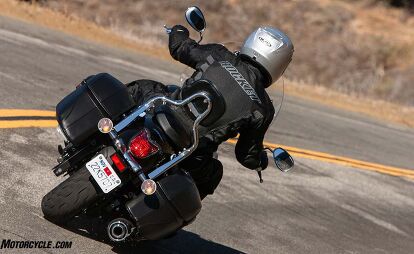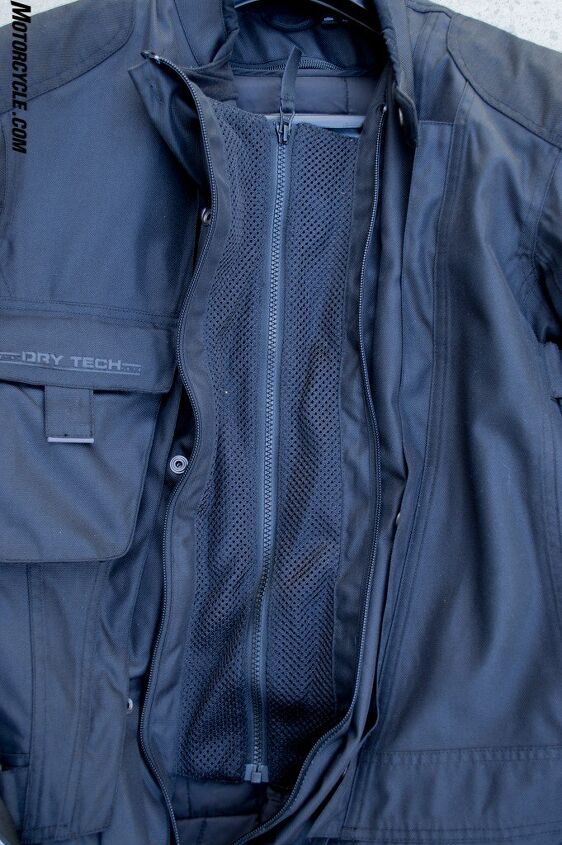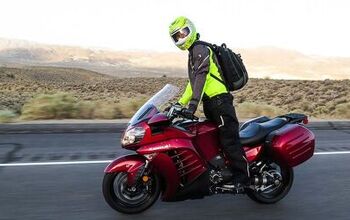MO Tested: Joe Rocket Survivor 1-Piece Oversuit

Joe Rocket tries its hand at the do-it-all street suit
When it comes to one-piece riding suits for the streets, Aerostich has been the benchmark others have strived to equal. Anecdotally speaking, I see more Aerostich suits on the road than I do any other brand. Ironically, I never quite meshed with the ‘Stich suit I had in the past as it restricted my leg movement while riding. Shame, since I really wanted to like the suit as the concept behind it is solid.
Joe Rocket Survivor 1-Piece Oversuit
| Aesthetics | 7.5/10 |
| Protection | 9.0/10 |
| Value | 10.0/10 |
| Comfort/Fit | 9.0/10 |
| Quality/Design | 8.5/10 |
| Weight | 8.0/10 |
| Options/Selection | 7.5/10 |
| Innovation | 8.0/10 |
| Weather Suitability | 9.5/10 |
| Desirable/Cool Factor | 8.0/10 |
| Overall Score | 85/100 |
Several years ago I was lucky to come across an imitator to the Aerostich Roadcrafter from Spidi that I really loved. It was waterproof, relatively easy to slip on over my regular clothes, and provided all the range of motion I could want on the street. Unfortunately, the waterproof main zipper eventually came apart and Spidi long discontinued the suit, leaving me no option but to retire my trusty riding partner. I’ve been looking for a new riding companion ever since.
Enter Joe Rocket and its Survivor 1-Piece Waterproof Suit. Built to be an oversuit that can be worn all year long, the Survivor has some unique features. Constructed from a RockTex 600 outer shell with a waterproof treatment, the material provides abrasion resistance from neck to ankles in a crash. CE-rated armor rests in the shoulder, elbow, and knee areas for impact protection, while a secondary layer of RockTex 600 fabric is applied for extra abrasion resistance. A soft back pad helps absorb impact, and can be removed to fit Joe Rocket’s Speedmaster 2.0 back protector (sold separately) if desired. YKK zippers are used throughout, and the main opening is shielded from the elements via a two-inch panel that uses snaps to fasten and channels water away from the zipper.
To cope with cold weather, the Survivor has a fully removable quilted liner from top to bottom. With just jeans and a t-shirt underneath, I found the liner useful when ambient temps reached into the low 60s. Depending on the amount of wind protection your motorcycle has (and your tolerance to cold weather), it’s possible to wear the suit when temps get even lower. I’m not that tough, but thankfully, since the suit is built to be worn over your regular clothing, there’s still room to wear a few layers underneath.
At the opposite end of the spectrum, the Survivor features a clever dual-zipper closure system that allows you to pull down the main zipper. Snaps along the side keep the flaps in place. Doing this exposes a 19-inch zippered mesh panel underneath – JR calls it the Big Air ventilation system – that exposes your core directly to the oncoming wind while you’re riding – a nice feature to have on warmer rides. Two 8-inch rear exhaust vents lets air circulate around the body.
While I haven’t yet ridden with it in truly hot summer conditions, the Big Air vent really works in funneling in a ton of cooling air. Ventilation to the lower body is possible, but it requires pulling down the top zip of the dual-zipper leg closures. While this opens the suit to allow air in, it also exposes the rider’s leg in the event of a fall. This is something Joe Rocket doesn’t endorse and is not recommended.
It was the fact the Survivor could be so adaptable to changing weather conditions and be worn over normal clothes that attracted me to it in the first place – and once the suit is on, it’s an impressive piece of kit, but more on that in a moment.
Donning the suit is perhaps my biggest gripe about the survivor. Unlike other oversuits, the Aerostich most notably, the Survivor does not feature a full-length zipper for easy entry. Each leg has a separate zipper while the main zip extends from the neck to the groin area.
It may not sound like a big distinction, but trying to fit the Survivor on over your clothes – especially with the added bulk of the quilted liner if it’s in place – without the full-length zip opening is nowhere near as easy as the ‘Stich. I found the easiest way to don the suit is to sit, get both legs in, zip each leg (starting with each leg of the liner if it’s installed), then stand and get both arms in and close off the suit. To be fair, the liner is a nice feature to have on chilly rides, and donning the suit is much easier when it’s removed.
Once on, the Survivor is a comfortable riding suit. It features no less than 14 hook-and-loop adjustment straps throughout to help provide a tight and secure fit. A fleece-lined mandarin collar gives the neck something soft to rub against, though it’s a bit disappointing that the neck closure is a single snap, meaning it only has one position and it can’t be tightened or loosened for rider preference or weather conditions.
One internal pocket in the suit is large enough to fit a wallet and smartphone, and there’s another pocket within the quilted liner, too. Three external waterproof pockets – two on the left thigh and one over the right breast – are also available to store phones, wallets, keys, even maps if they’re folded over a few times.
Riding with the Survivor, the gripes about putting the suit on fade into the distance. It’s a comfortable suit to wear and doesn’t restrict movement no matter what kind of motorcycle I’m riding. From sportbikes to cruisers, never did I find myself restricted. The accordion stretch panel across the lower back is another feature allowing for natural range of movement.
With the Big Air vent closed and the liner in place, the suit does a good job blocking out the elements. I’ve been holding off on writing a review about this suit until I was able to test its waterproofness, and a recent rain storm in the area finally allowed me to do so. Perched in the sportbike position while riding a GSX-R1000, the heavens opened up on me, and for the most part the Survivor performed well. Rain mostly stayed on the exterior of the suit where it belongs, though my forward riding position combined with the inability to adjust the collar closure exposed my neck. Sure enough, I slowly felt a trickle glide down my neck and onto my back.
Once home and with the suit off, an examination of my clothes curiously found a small wet patch on the back of my right thigh. My guess is the water trickled down my neck and finally stopped at my thigh. Weird. Otherwise, I remained dry everywhere else, with no puddles in the crotch area, a problem area reported by ‘Stich owners until the waterproof Roadcrafter 3. I was also impressed with the external waterproof pockets. My wallet and phone that were placed in them remained completely dry.
Overall, I’m fairly happy with the Survivor suit. Yes it’s a pain to put on, and allows a little bit of water in if you’re on a sportbike, but once on it’s a great jack-of-all-trades kind of suit that allows you to wear your normal clothes underneath so you don’t look like a weirdo once you get to your destination. It’ll work for nearly all weather conditions, too.
Had I not been riding hunched over on a sportbike, my helmet would have diverted more rain from entering through the collar (though I still wish it was more adjustable). I could easily see this suit replacing several pieces of touring gear for someone going on a long haul. Just pack some under layers for cooler weather, and be prepared for warm legs in hotter climes. If you’re looking for one piece of gear to (almost) do it all, the Survivor is worth a look.
Available in Black in sizes Small – 2XL (including short inseams in all sizes except Small), and in Hi-Viz Neon in sizes Small – 2XL (no short inseam option), the Survivor costs $399.99 – $419.99. Compare that to the $1,197 price tag of the aforementioned Roadcrafter, and the Survivor is a huge bargain. Visit the Joe Rocket website for more details, including a sizing chart.

Troy's been riding motorcycles and writing about them since 2006, getting his start at Rider Magazine. From there, he moved to Sport Rider Magazine before finally landing at Motorcycle.com in 2011. A lifelong gearhead who didn't fully immerse himself in motorcycles until his teenage years, Troy's interests have always been in technology, performance, and going fast. Naturally, racing was the perfect avenue to combine all three. Troy has been racing nearly as long as he's been riding and has competed at the AMA national level. He's also won multiple club races throughout the country, culminating in a Utah Sport Bike Association championship in 2011. He has been invited as a guest instructor for the Yamaha Champions Riding School, and when he's not out riding, he's either wrenching on bikes or watching MotoGP.
More by Troy Siahaan














































Comments
Join the conversation
I had an old Tourmaster Cortech suit that you entered the same way -- I liked that method more than the Roadcrafter's way (I have one now). You get used to either method of getting in or out.
Does the Survivor have openings to your pants pockets? Is there a waterproof path to run a wire for heated gear? The Roadcrafter has a pocket where the wire pulls the zipper down and lets water inside the suit -- a huge flaw for a year around suit.
I have one and use it everyday. it's a bit bulky on the front but definitely functional under all temperatures here in Southern California.